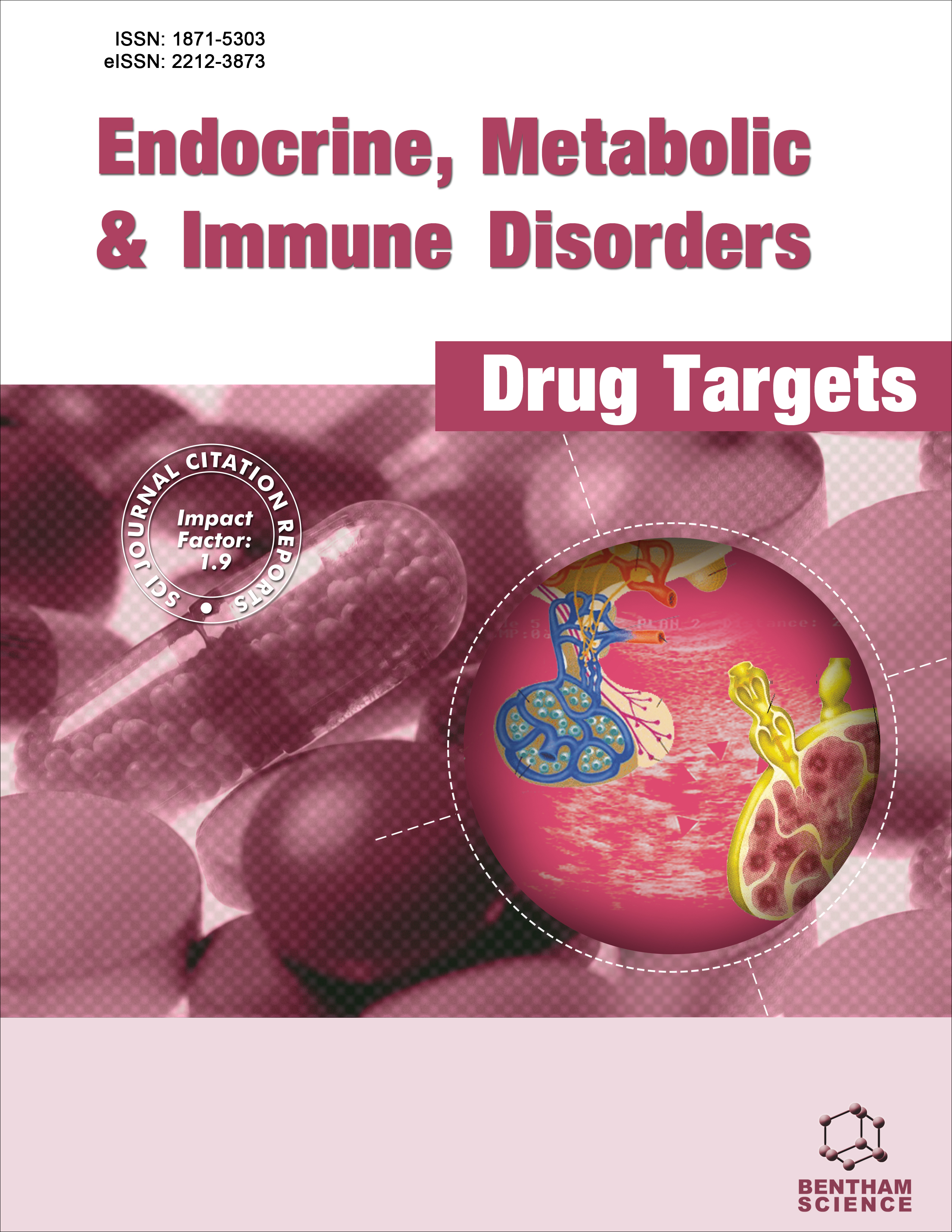- Home
- A-Z Publications
- Endocrine, Metabolic & Immune Disorders-Drug Targets (Formerly Current Drug Targets - Immune, Endocrine & Metabolic Disorders)
- Previous Issues
- Volume 8, Issue 1, 2008
Endocrine, Metabolic & Immune Disorders-Drug Targets (Formerly Current Drug Targets - Immune, Endocrine & Metabolic Disorders) - Volume 8, Issue 1, 2008
Volume 8, Issue 1, 2008
-
-
Possible Roles of Reg Family Proteins in Pancreatic Islet Cell Growth
More LessAuthors: Jun-Li Liu, Wei Cui, Bing Li and Yarong LuReg proteins constitute a conserved family in human and rodents; their production in the pancreas (including the islets of Langerhans) is induced upon β-cell damage. While some members of the family (Reg1 and islet neogenesisassociated protein, i.e. INGAP) have been implicated in β-cell replication and/or neogenesis, including from in vivo studies using transgenic and knockout mice; the roles of the other five members ha Read More
-
-
-
The Use of Mycophenolate Mofetil for the Treatment of Systemic Sclerosis
More LessAuthors: Max Shenin, Manisha Naik and Chris T. DerkMycophenolate mofetil (MMF) is an inosine monophosphate dehydrogenase inhibitor, that inhibits the de novo pathway of guanosine nucleotide synthesis, the proliferative responses of T and B lymphocytes as well as antibody production by B-lymphocytes. It is indicated for the prophylaxis of organ rejection after allogeneic cardiac, hepatic and renal transplants . It has recently also been used with good success in patients with Read More
-
-
-
Host-Pathogen Interactions in Latent Mycobacterium tuberculosis Infection: Identification of New Targets for Tuberculosis Intervention
More LessAuthors: May Y. Lin and Tom H.M. OttenhoffMycobacterium tuberculosis (M. tuberculosis) is one of the worlds' most successful and sophisticated pathogens. It is estimated that over 2 billion people today harbour latent M. tuberculosis infection without any clinical symptoms. Since most new cases of active tuberculosis (TB) arise from this (growing) number of latently infected individuals, urgent measures to control TB reactivation are required, including more effective Read More
-
-
-
The HIV-1 Rev Binding Family of Proteins: The Dog Proteins as a Study Model
More LessVarious proteins that are required for the building of new complete human immunodeficiency type 1 virions (HIV-1) are coded by unspliced or partly spliced virus-derived mRNAs. HIV-1 has developed special strategies for moving these mRNAs to the cytoplasm to be translated. In the nucleus of the infected cell the virus-derived protein Regulator of expression of viral proteins (Rev) can bind both the viral intron-containing mRNAs Read More
-
-
-
Distinct Functions of Retinoic Acid Receptor Beta Isoforms: Implications for Targeted Therapy
More LessAuthors: Catherine B. Swift, John L. Hays and W. J. PettyVitamin A is essential for development and differentiation of multiple tissues. Its derivatives, the retinoids, are potent drugs used to treat and prevent a variety of diseases. Retinoid effects are mediated by retinoic acid receptors (RARs) and retinoid X receptors (RXRs). There are three known RARs (α, β, and γ), and multiple isoforms of each receptor exist. Many of the therapeutic effects of retinoids including cancer che Read More
-
-
-
G Protein Coupled Receptors as Drug Targets: The Role of β-Arrestins
More LessAuthors: Jasmin R. Dromey and Kevin D.G. PflegerG protein coupled receptors (GPCRs) are extremely important drug targets and the β-arrestin intracellular scaffolding and adaptor proteins regulate major aspects of their pharmacology. β-arrestin binding to activated, GPCR kinase (GRK)-phosphorylated receptors has the capacity to terminate G protein coupling, internalize the receptors into clathrincoated vesicles and establish a secondary signaling complex independent of G pro Read More
-
-
-
Monoclonal Antibodies: New Therapeutic Agents for Autoimmune Hemolytic Anemia?
More LessAuthors: Giovanni D'Arena, Ronald P. Taylor, Nicola Cascavilla and Margaret A. LindorferConventional treatment of autoimmune hemolytic anemia (AIHA) comprises corticosteroids and splenectomy and/or other immunosuppressive drugs for refractory/relapsed patients. Monoclonal antibodies (MoAbs) rituximab and alemtuzumab have gained widespread acceptance in the management of B-cell malignancies. More recently, they have been used to treat a number of autoantibody-mediated diseases, such as Read More
-
-
-
Epithelial-Mesenchymal Transition as a Therapeutic Target for Prevention of Ocular Tissue Fibrosis
More LessFibrotic diseases are characterized by the appearance of myofibroblasts, the key cell type involved in the fibrogenic reaction, and by excess accumulation of extracellular matrix with resultant tissue contraction and impaired function. Myofiborblasts are generated by fibroblast-myofibrobalst conversion, and in certain tissues through epithelialmesenchymal transition (EMT), a process through which an epithelial c Read More
-
Volumes & issues
-
Volume 25 (2025)
-
Volume 24 (2024)
-
Volume 23 (2023)
-
Volume 22 (2022)
-
Volume 21 (2021)
-
Volume 20 (2020)
-
Volume 19 (2019)
-
Volume 18 (2018)
-
Volume 17 (2017)
-
Volume 16 (2016)
-
Volume 15 (2015)
-
Volume 14 (2014)
-
Volume 13 (2013)
-
Volume 12 (2012)
-
Volume 11 (2011)
-
Volume 10 (2010)
-
Volume 9 (2009)
-
Volume 8 (2008)
-
Volume 7 (2007)
-
Volume 6 (2006)
Most Read This Month
Article
content/journals/emiddt
Journal
10
5
false
en


